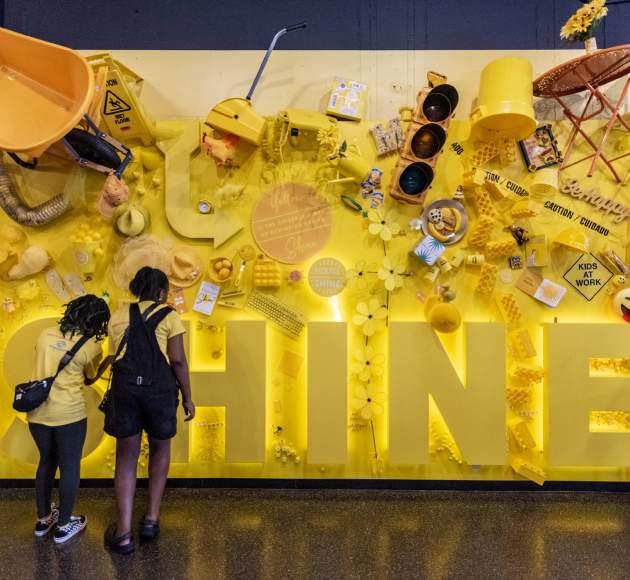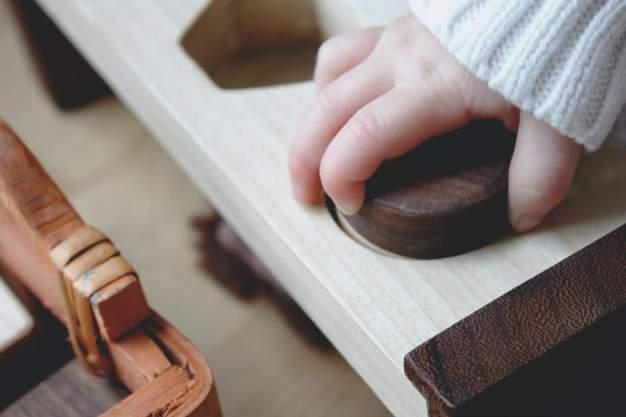Sustainable Exhibition Design & Construction
Toolkit
Environment and Climate Network American Alliance of Museums
v1 May 2022
About the Museum Exhibition Materials Pledge The Museum Exhibition Materials Pledge is an invitation to museums and museum exhibition designers to start a conversation about the definition of sustainability. Much of the language from the letter comes from 2019 Materials Pledge supported by the American Institute of Architects (AIA). We hope that defining “sustainability” for you and for your institution can lead to more specific actions. Signing the pledge is your opportunity to make a public statement that you are committed to making more informed choices and to engaging in an ongoing dialogue with manufacturers to help them improve the transparency and the sustainability of their products.
About the Sustainable Exhibition & Design Toolkit
Page 2
Once you have signed the letter, what are the next steps? This toolkit that follows the pledge will help you to transform your commitment into specific actions that will reduce negative impacts to our climate and to our society.
Sustainable Exhibition Design & Construction Toolkit v1, May 2022
Museum Exhibition Materials Pledge
To interior finish and graphic substrate manufacturers: As members of the museum exhibition community, including, but not limited to, the Alliance for American Museums (AAM) National Association for Museum Exhibition (NAME) and the Environment and Climate Network (ECN), we work towards accelerating change in the manufacturing community. Inspired by the AIA (American Institute of Architects) Materials Pledge of 2019 and the Lighting Advocacy Letter of 2021, we unite as museum exhibition designers, fabricators, and installers to ask manufactures to continue to raise their standards of transparency while providing long-lasting, high-quality materials that positively impact all people. As museum exhibit designers, fabricators, and installers, we join with our colleagues who have signed the 2019 AIA Materials Pledge, and we also pledge to: •
•
•
• •
support human health by preferring products that support and foster life throughout their life-cycles and seek to eliminate the use of hazardous substances. support social health & equity by preferring products from manufacturers that secure human rights in their own operations and in their supply chains, positively impacting their workers and the communities where they operate. support ecosystem health by preferring products that support and regenerate the natural air, water, and biological cycles of life through thoughtful supply chain management and restorative company practices. support climate health by preferring products that reduce carbon emissions and ultimately sequester more carbon than emitted. support a circular economy by reusing and improving buildings and by designing for resiliency, adaptability, disassembly, and reuse, aspiring to a zero-waste goal for global construction activities.
To address these concerns and to meet our goals of transforming the industry, we commit to continuously updating our design libraries and specifications. We commit to sharing best practices, educational resources, and preferred products with our museum exhibition community. We further commit to giving priority to products and manufacturers with a commitment to: • • • •
Provide publicly available material ingredient disclosure information. Provide publicly available environmental impact disclosure information. Provide publicly available Design for Freedom supplier questionnaires or similar supply chain disclosure information. Do not stop at material transparency but strive for optimization.
To achieve this goal, we must work together as museum leadership, museum boards, exhibit directors, curators, exhibit designers, graphic designers, lighting designers, audiovisual designers, audiovisual specifiers and installers, building product manufacturers, graphic print houses, exhibit fabricators and exhibit installers to build awareness, share knowledge, drive demand, and deliver solutions. We ask you, as responsible product manufacturers, for your commitment to work towards market transformation in the museum exhibition world. To accelerate this mission and to leverage cross-industry insight and expertise, we seek your partnership in advancing this conversation at upcoming industry annual meetings, conferences and trade shows. We value our relationship with each of you and we understand that the change we seek will not be accomplished overnight. Please join us in continued dialogue and collaboration as we learn from each other and improve the best practices of museum exhibitions.
Sincerely, MUSEUM EXHIBITION MATERIALS PLEDGE SIGNATORIES
Museum Exhibition Materials Pledge Signatories To sign on to the pledge, send your logo to dflandro@cambridgeseven.com.
Toolkit Don’t Worry about “Perfect.” Work towards “Better.” Few museums have the resources to follow all of these guidelines. Don’t get discouraged or overwhelmed. Start with low-hanging fruit. Learn more with each project and make each project better than the last. These resources are designed to help you define and improve the sustainability of your exhibitions in the ways that are most important to your community and your institution.
Table of Contents 8
Project Timeline
9
Design for Human Health Design for Social Health and Equity
12
Design for Ecosystem Health
14
Design for Climate Health
16
Design for the Circular Economy
17
Product Specific Guidelines
20
Sustainable Material Resources
Page 7
10
Sustainable Exhibition Design & Construction Toolkit v1, May 2022
Project Kickoff • Start building design team awareness of different sustainable priorities. • Hold a team kickoff meeting where sustainability goals are shared and established. • Involve community partners.
• • • • •
Concept/Schematic Design Remind design team of sustainability goals and priorities. Research salvage and reuse opportunities. Can salvaged materials be sourced? Begin transparency research for large-volume finish and millwork materials. Have budget conversations. Where can sustainability save money? Design documents should include narrative language outlining requirements.
Photo by Braden Collum on Unsplash
Project Timeline
Design Development Start conversations with product representatives. Focus on design for deconstruction using clips and screws, not nails and glues. How can salvaged materials help tell the story of the exhibit? Design documents should include specific requirements for transparency, absence of specific toxic materials, sustainably sourced material ingredients, and low carbon footprint materials according to sustainability goals. • Meet with community partners to check environmental justice assumptions. • • • •
Bid/Construction Administration • Hold pre-bid and kickoff meeting to review and clarify expectations with the client and the construction team. • Review submitted transparency documentation and third-party verification documentation as requested in bid/contract documents • Review any suggested substitutions to confirm that they comply with sustainability goals. Sustainable Exhibition Design & Construction Toolkit v1, May 2022
Page 8
Contract/Bid Documents • Ensure specification language and in the contract documents or bid documents, outline all sustainability goals with specific requirements.
Design for human health by avoiding toxic chemicals in exhibit flooring, wallpaper, graphic substrates, woods, fabrics, adhesives, paints and carpeting. Prioritize materials touched by visitors, especially by children. Low Emissions • Develop a plan to use materials that have been tested according to regulations from CPHD (California’s Department of Public Health)’s emissions testing v1.2. • Document 5 to 20 materials that have CPHD emissions testing and/or zero VOC content. • Install onsite air-quality monitoring with automated increased outdoor air ventilation, when required.
Photo by Sigmund on Unsplash
Design for Human Health
No PVC (Polyvinyl chloride) • Choose flooring materials with no PVC. • Choose wall murals with no PVC. • Choose graphic substrates with no PVC. Avoid Red List Ingredients • Avoid materials from the International Living Future Institute (ILFI) Red List. These “worst in class” materials, chemicals and elements are known to pose serious risks to human health.
RoHS Compliant Lighting and Audiovisual Equipment • Restriction fo Certain Hazardous Substances (RoHS) is used for electrical and electronic equipment. It limits the use of materials such as lead, mercury, cadmium, hexavalent chromium, polybrominated biphenyls (PBB) and polybrominated diphenyl ehters (PBDE). Sustainable Exhibition Design & Construction Toolkit v1, May 2022
Page 9
Material Transparency • Choose materials with Health Product Declarations (HPDs) or other methods to demonstrate the chemical inventory of the product to at least 1000 ppm (0.1%). • Select materials with Declare Labels.
Design for Social Health and Equity
Ethnic Diversity • Document goals to increase ethnic and racial diversity among the exhibit project team. Research the regional ethnic groups and racial minorities in your community and set goals to match the % of each group in the design team. • Talk with museum leadership about establishing goals to match regional ethnic and racial diversity on the museum board and in museum leadership. • Hire minority-owned businesses and design/fabrication partners.
Photo by Yasin Yusuf on Unsplash
Ensure that the entire project team truly embraces Diversity, Equity, Accessibility and Inclusion (DEAI) goals by setting them early in the planning process. A nondiverse team will not be able to see blind spots in exhibit content and in exhibit sustainability goals. In areas where the exhibit team lacks diversity, reach out to community partners and specialists to review the design at several points throughout the design process. This will make the exhibition richer and more accessible to all diverse groups in our community.
Gender Diversity • Document goals of the project to increase gender and sexual identity diversity on the design team. • US national statistics for 2022 show 51% women and 49% men1 with 7% selfidentifying as part of the LGBT+ community2 (Lesbian, Gay, Transgender, Bisexual, plus other non-traditional gender and sexual identities). How does your team compare? • When hiring consultants, artists and fabricators, consider setting goals to match your regional sexual diversity.
1 Total Population in the United States by Gender from 2010 to 2025, statissta.com, (collected 12 May 2022) 2 Jones, Jeffery M., LGBT Identification in U.S. Ticks Up to 7.1%, news.gallup.com, 17 February 2022, (collected 12 May 2022)
Sustainable Exhibition Design & Construction Toolkit v1, May 2022
Page 10
Community Outreach • Identify and engage traditionally underrepresented community partners in the exhibit development and design process. When possible, hire these members as part
of the design team. • Establish regular community review points and workshops. Ensure that community members drive decision-making by planning for a realistic project timeline and staffing resources that fully engage traditionally underrepresented groups. Living Wage • Using the MIT (Massachusetts Institute of Technology) Living Wage Calculator for your location, pay entry-level employees, on salary and on limited contracts, at minimum a living wage for a two-working-adult and two-child family unit. Design for Freedom • Research high-risk product types to ensure exhibit construction is 100% free from forced or child labor. • Develop a plan to ask suppliers and manufacturers about and avoid products with forced or child labor in the supply chain. Ensure all workers in the supply chain receive a fair wage. These materials are especially high-risk: Glass, Gypsum, Polysilicone (used in solar panels), Rubber, Silica, Stone, Textiles, and Timber. • Ask suppliers of high-risk products to fill out Design for Freedom Supplier Questionnaires3 to further examine their supply chains.
3
designforfreedom.org
Sustainable Exhibition Design & Construction Toolkit v1, May 2022
Page 11
Universal Design • Ensure that the exhibit complies with all federal ADA (Americans with Disabilities Act) guidelines. • Consult with a universal design specialist to discuss how the exhibit could go beyond ADA guidelines to improve universal access.
Photo courtesy CambridgeSeven
Design for Neurological Diversity • Consult with an autism spectrum specialist to discuss how exhibit elements can better accommodate neurologically diverse visitors. • Design exhibits with clearly marked places of refuge throughout the visitor experience path. • Create methods for visitors to plan full itineraries in advance of their visit by using icons and landmarks. These are most helpful if visitors can see the icons and landmarks visually on their personalized itineraries.
Design for Ecosystem Health
Third Party Certification • B Corp companies are certified by the B Lab to preserve ecosystems and support local communities. • Benefit Corporations need to show that they put social and environmental values on an equal footing with profits. • Just certification by the International Living Future Institute is a voluntary disclosure tool focusing on transparency surrounding equity, diversity and employee welfare. It also looks at animal welfare and examines the company’s supply chains. Sustainable Exhibition Design & Construction Toolkit v1, May 2022
Page 12
Corporate Sustainability Reports and Take-Back Programs • Look for companies that have Corporate Sustainability Reports (CSRs). The Global Reporting Initiative (GRI) sets standards for these reports to ensure that they are more than just green-washing. • Extended Producer Responsibility (EPR) programs, better known as “Take-Back” programs means that the company has established a method to reclaim and recycle their products. This goes beyond the dubious claim of “recyclable.” Look for documentation that products are actually being recycled at a high rate. Many commercial carpet and ceiling tile companies have established EPR programs.
Photo by David Clode on Unsplash
Consider the full life cycle of products and prefer those that mimic or use natural regeneration processes. Which products break down easily and will end their useful lives in the compost bin rather than the landfill? Are there ways that the exhibit can extend outdoors to regenerate natural habitat for local wildlife? Do your corporate sponsors support healthy ecosystems?
Biobased Materials • Look for products made with a high degree of natural materials that will eventually breakdown naturally and not end up in landfills.
Page 13
Bird Friendly Windows • If you have large windows in your exhibit hall, consider methods of minimizing reflection of trees, bushes and sky in your windows to reduce bird strikes. Netting, insect screens, blinds, wires, vines, paint, stickers or glass frit are all methods that help indicate to birds that there is a physical barrier present. A 2x4-inch grid will keep most birds safe. Window manufacturers are now making transparent coatings that are nearly invisible to humans, but not to birds.
Photo and Design by Derek Tan, Beaty Biodiversity Research Centre, The University of British Columbia
Forest Stewardship Council (FSC) Wood • Although not perfect, FSC wood remains the best standard for ecosystem friendly wood harvesting. Cost premiums are much less than they used to be and FSC certified wood is more available than ever.
Sustainable Exhibition Design & Construction Toolkit v1, May 2022
Design for Climate Health Just as many museums are examining their operational energy use, many building product suppliers are examining the embodied carbon of their materials. Embodied carbon is the total carbon released into the atmosphere as a result of the extraction, manufacture, transportation, sale, installation, use, deconstruction and disposal or reuse of a product. Plan early to design for overall climate health by using Environmental Product Declarations (EPDs) to determine the Global Warming Potential (GWP) of materials as well as setting a cap on the exhibit’s total carbon footprint.
Low Global Warming Potential (GWP) Materials • Use tools like Sustainable Mind’s transparency catalog1 or Carbon Cure’s Embodied Carbon in Construction Calculator2 to find products that are low in embodied carbon compared to their competitors.
Photo by Dan Meyers on Unsplash
Global Warming Potential Transparency with Environmental Product Declarations (EPDs) • Choose materials with EPDs (a carbon “life story” of the product) which conform to ISO 14025 and EN 15804 or ISO 21930.
1 2
transparencycatalog.com buildingtransparency.org
Sustainable Exhibition Design & Construction Toolkit v1, May 2022
Page 14
Reduce Transportation Carbon Footprint • Use virtual tools for workshops and reviews in order to limit air travel during the exhibit planning process, especially for outside consultants. • Use local artists, illustrators and craftspeople to fabricate exhibits. • If travel is necessary, offset with purchased carbon credits.
Energy Use Reduction • Early in the exhibit design process, set a shared media & lighting Energy Use Intensity (EUI) not-to-exceed target toward overall power use. Estimate the energy that will be used by exhibit lighting and media and develop a plan to reduce power in both areas. High tech EUI studies could involve computer models and computerized building management systems. A low-tech way of studying EUI is to create a spreadsheet, inventory fixtures and AV hardware, figure out how much wattage each uses and how many hours/per day it will be used, then calculate the annual energy usage per square foot. EnergyStar publishes average EUI baselines. As of 2021, the baseline EUI for museums is 56.1 kBtu/ft2.
Page 15
Audiovisual (AV) • Choose motion sensors, or similar technology, to move AV to low power mode when not in use. • Track AV with Energy Use Intensity (EUI, annual kBtu/square feet), and plan to reduce from business as usual design. • Offset exhibit AV use with renewable energy generation toward a goal of Net Zero.
Photo by DESIGNECOLOGIST on Unsplash
Lighting • Choose LED lighting as well as light or motion sensors to shut off or dim lights when not in use. • Track lighting with Energy Use Intensity (EUI, annual kBtu/square feet), through a spreadsheet or with real-time monitoring. • Offset exhibit lighting use with renewable energy generation toward a goal of Net Zero.
Sustainable Exhibition Design & Construction Toolkit v1, May 2022
Design for the Circular Economy Through a combination of salvage and recycling, develop a design plan for reducing, reusing, and recycling exhibit materials including furniture, hardware and substrates.
Salvaged Material Use • Establish resources with theaters or film boards in your community to harvest plywood and other gently used construction materials. • Use All for Reuse’s opensource map of salvage opportunities1. • Look to current exhibits to find ways to reuse exhibit elements in-house. Recycled Material Use • Choose recycled materials for exhibit furniture and features. Recycled material documentation is largely unregulated and based on manufacturer claims. • Post-consumer recycling is more challenging for producers than pre-consumer, or post-industrial recycling, as it requires work to eliminate contaminates. Preferring post-consumer recycling creates a market for used materials and diverts materials from the landfill. Post-industrial materials are still considered “virgin” materials.
Photo courtesy of CambridgeSeven
Design for Deconstruction • Choose clips and screws instead of nails and glue to attach exhibit materials. • Plan to document which exhibit features and systems are designed for reuse, and how to easily disassemble them.
1
allforreuse.org
Sustainable Exhibition Design & Construction Toolkit v1, May 2022
Page 16
End-of-Life Plan • Plan for “Deconstruction” and reuse instead of “Demolition” and sending materials to landfills. • Determine percentage of materials and finishes to be sent to landfill.
Product Specific Guidelines Here is a list of third-party standards that you can trust when looking at specific interior finish products.
Metal Finish • High Performance Latex, use the same CDPH Standard Method Emissions Evaluation and VOC content standards as above. • Powder coating can be made from polyester, acrylic, polyurethane, or hybrids. Powder coating is much more durable than latex paint, but more difficult to touch up. It can use less energy to apply than liquid coatings and minimizes waste. Avoid epoxies and fluoropolymers. Medium Density Fiberboard (MDF), Plywood, and Particleboard • Meet California Air Resources Board (CARB) ultra-low emitting formaldehyde (ULEF) or no-added-formaldehyde (NAF) emissions requirements Sustainable Exhibition Design & Construction Toolkit v1, May 2022
Page 17
Interior Stains and Finishes • CDPH Standard Method Emissions Evaluation • Below South Coast Air Quality management District (SCAQMD) limits for VOC Content • Greenguard Gold
Photo by David Pisnoy on UnSplash
Low Emitting, High Performance Paints • California Department of Public Health (CDPH) Standard Method Emissions Evaluation • Less than 50 g/l of (Volatile Organic Compound) VOC content measured after tinting • MPI X-Green Performance Standard Certification for high performance and low VOC paints.
• Forest Stewardship Council (FSC) certified or recovered waste fiber
Low Emitting and Low Life Cycle Impact Modular Carpet • Certified to CRI Green Label Plus • Certified to C2C v3.1 Silver or higher, NSF 140 Platinum or Living Product Challenge
Photo courtesy of CambridgeSeven
Countertops • Natural Stone • ANSI/NSC 373 and/or C2C Silver or higher • Avoid sealers • Engineered Stone/Quartz • C2C Silver or higher • Declare Red List Free • Low Emissions • Natural Wood • Local species
• • • •
Wood Flooring • Pre-finished, bamboo or FSC solid wood floors, or salvaged wood that can be installed without an adhesive are ideal. • Look for CPHD Emissions Testing Sustainable Exhibition Design & Construction Toolkit v1, May 2022
Page 18
•
Polished Concrete Flooring Often cheaper and lower maintenance than any other flooring choice Densifying the surface increases durability Polished floors can be died many colors Pay attention to acoustics Reduce material use by polishing new or existing concrete slabs
Photo courtesy of CambridgeSeven
Resilient Flooring • Linoleum or Natural Rubber Flooring • Greenguard Gold Certification • C2C Silver or Higher
Tile Flooring • Ceramic and porcelain tiles made in the USA likely have eliminated toxic glazes and are inherently non-emitting. Tiles made abroad may contain lead in glazes. • Avoid epoxies in grout. • Avoid Cathode Ray Tube filler material. • Prefer products with a Health Product Declaration (HPD).
•
• • •
•
• • • • •
Photo courtesy of CambridgeSeven
•
Alternatives to Vinyl Wall Murals Monadnock Envi Commercial Wallpaper Acrovyn By Design wall protection panels (very durable, PVC-free, seams every 4ft.) 3M Envision Print Wrap Films – PVC free Digitally printed fabric High Pressure Laminate or phenolic (FSC available through Wilsonart) Direct-to-substrate prints on plywood Alternatives to PVC Substrates for Graphic Panels BioBoard Ex-Cel PVC Free foam board Eco-fi Fabric PVC-free options by Cooley Group in Rhode Island Plyboo or ApplePly panels
Page 19
• • • • • • •
Textiles facts certified - Gold or Platinum, C2C Gold, SCS Indoor Advantage Gold Natural Fibers – GOTS or Oeko Tex 100 Avoid antimicrobials Avoid Per- and Polyfluoroalkyl Substances (PFAS) Avoid stain treatments, flame retardants Avoid PVC Avoid mixed natural and synthetic fibers, pure natural or pure synthetic fibers are easier to recycle.
Sustainable Exhibition Design & Construction Toolkit v1, May 2022
Sustainable Material Resources • • • • • • • • • • •
BuildingGreen.com (subscription) excellent product guides Homefree.healthybuilding.net Products.ecomedes.com origin.build/#/materials transparencycatalog.com mindfulmaterials.com declare.living-future.org Healthymaterialslab.org Sixclasses.org EC3 website for baseline embodied carbon for interior finishes STiCH.culturalheritage.org - Sustainability Tools in Cultural Heritage - Carbon Calculator
Toolkit Authors
• Douglas Flandro, LEED AP ID+C and BD+C, CPHD, CambridgeSeven • Rachel Moritz, Exhibit Content Developer and Writer
American Alliance of Museum’s Environment and Climate Network Board Brenda Baker, Madison Children’s Museum Susan Elmore, CPSM, CambridgeSeven Samantha Mera-Candedo, Experiences at National Geographic Society Kate Curto, New York Hall of Science National Association of Museum Exhibition’s (NAME) Feedback Fridays
Page 20
• • • • • •
Thank You to Our Valuable Collaborators
Sustainable Exhibition Design & Construction Toolkit v1, May 2022







